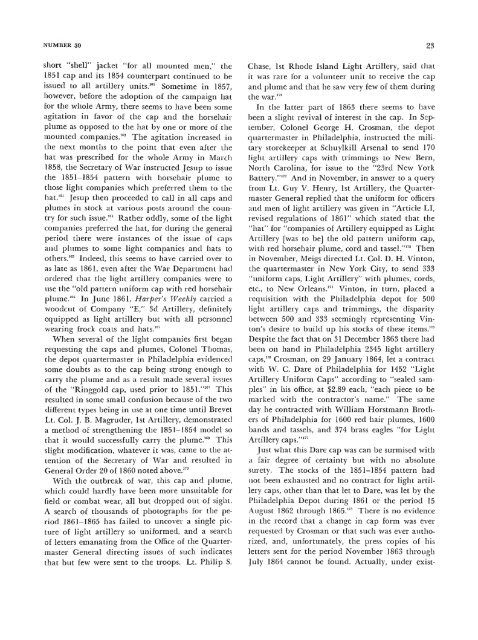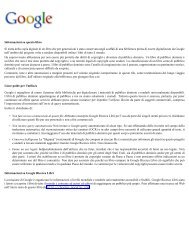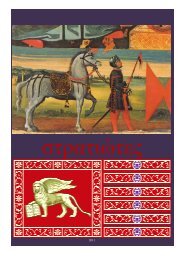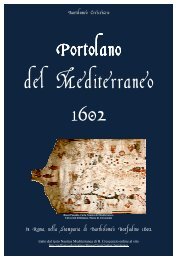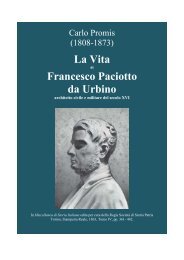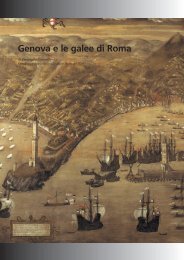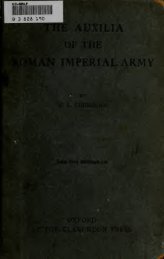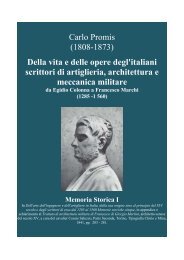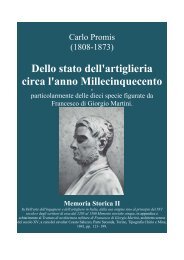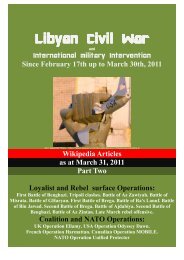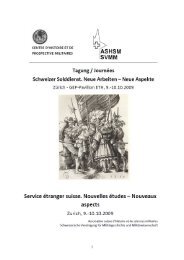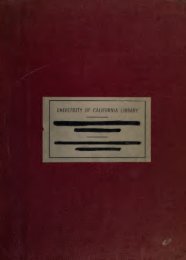22 SMITHSONIAN STUDIES IN HISTORY AND TECHNOLOGYTHE 1864 LIGHT ARTILLERY CAPThe term "Light Artillery" for many years wasloosely used to include both "horse'' or "flying"artillery in which all personnel were individuallymounted, and "mounted" or "harnessed" artillery,in which some personnel were individually mountedand the remainder rode the caissons and limbers.In the Civil War, the term generally indicated theartillery which accompanied the army in the fieldas opposed to fortress or siege artillery."""Light" artillery in the <strong>Army</strong> properly datesfrom 1808 with the organization of the Regimentof Light Artillery. Of this unit, only one company,that of Captain George Peter, was ever mountedand then only for a period of about a year forreasons of economy. In the <strong>Army</strong> reduction of1821, the Regiment of Light Artillery was disbanded,all the artillery of the army being organizedinto four regiments, one company of eachregiment to be designated and equipped as lightartillery. The latter provision was inoperative until1838 when, at Secretary of War Poinsett's instance.Brevet Major Samuel Ringgold, commanding"C" Company, 3d Artillery, was directed toorganize a "light" company in which all personnelwere to be individually mounted; in other words,a company of "horse" artillery."'^ The followingyear one company from each of the other threeregiments was equipped as a "light" company asopposed to "horse." In 1847 Congress authorized anadditional company from each regiment to beequipped as light artillery. During the War withMexico some of these companies fought as "light"companies. Several never received their "light"equipment, and several fought as infantry. Followingthe war, a series of changes and counterchangesleft the Light Artillery in a state of fluxuntil the outbreak of the Civil War.Major Ringgold, who was an extremely aggressiveand influential officer, had no sooner begunthe organization of his "horse" company in 1838than he was agitating for a distinctive uniform forthe unit including first, dragoon caps, and then redhorsehair plumes.'^' The plumes were authorizedfor officers in 1839 and for enlisted men in 1841with bands and tassels added.'^Early in 1844 a board of officers, of which Ringgoldwas a member, was set up to consider thequantity of clothing issued to the <strong>Army</strong>. In its report,in addition to reporting on its assigned mission,the board made certain recommendations inregard to the headgear of the <strong>Army</strong>. Specifically, inregard to the Light Artillery, the report recommended:"For Mounted Artillery—according to themodified pattern, the band and tassel red, theplume of red horsehair . ""' Actually, before theboard rendered its report, some change in the patternof the cap to be issued the Artillery, and presumablythe Light Artillery as well, had been made.On 11 April 1844, the Quartermaster General, inreplying to a complaint of Lt. H. B. Judd, 3d Artillery,regarding the quality of the issue caps, wrotethat while the caps issued had been procured bythe late Commissary General, Mr. Tyson, ColonelHenry Stanton, the depot quartermaster at Philadelphia,had since been able to supply a cap ofbetter material at the same price. Two days laterhe wrote Captain J. B. Scott, 4th Artillery, in regardto issue of the new type. He stated that whilethe old pattern had to be issued until exhausted,the quality and pattern of the cap had been improved.'"Just what this change was is unknown,but since Ringgold was a member of the board andhad been successful in his advocacy of a distinctiveuniform for his "horse" company,"' the pattern mayhave been issued to his alone. As late as 1859 whenthe mounted companies were requesting distinctiveheadgear, letters to and from the QuartermasterGeneral and the Philadelphia Depot speak oflight artillery companies being supplied with "theuniform cap in use by them anterior to 1851" andof "the Ringgold Cap used prior to 1851.'"^° Althoughthe modification must have been slight, amodification it must have been, for the 1845 costof clothing lists carried the uniform cap of both"Light Artillery" and "Horse Artillery" at $1.27,with that of the Infantry and Artillery at $1.22 andthat of the Dragoons at $1.23. In the same lists theband and tassel of both the Light and Horse Artillerywas listed at $.53 and that of the Dragoons at$.50, and the hair plume of the former at $.78 andthe latter at $.42, indicating a difference throughout.'""The 1851 uniform change brought to an end,for several years at least, a distinctive uniform andheadgear for the Light Artillery. Although GeneralOrder No. 1 of 30 January 1854 authorized the
NUMBER 30 23short "shell" jacket "for all mounted men," the1851 cap and its 1854 counterpart continued to beissued to all artillery units."' Sometime in 1857,however, before the adoption of the campaign hatfor the whole <strong>Army</strong>, there seems to have been someagitation in favor of the cap and the horseliairplume as opposed to the hat by one or more of themounted companies."" The agitation increased inthe next months to the point that even after thehat was prescribed for the whole <strong>Army</strong> in Alarcli1858, the Secretary of War instructed Jesup to issuethe 1851-1854 pattern with horsehair plume tothose light companies which preferred them to thehat.'°' Jesup then proceeded to call in all caps andplumes in stock at various posts around the countryfor such issue."" Rather oddly, some of the lightcompanies preferred the hat, for during the generalperiod there were instances of the issue of capsand plumes to some light companies and hats toothers.'"' Indeed, this seems to have carried over toas late as 1861, even after the War Department hadordered that the light artillery companies were touse the "old pattern imiform cap with red horsehairplume.""' In June 1861, Harper's Weekly carried awoodcut of Company "E," 3cl Artillery, definitelyequipped as light artillery but with all personnelwearing frock coats and hats.'"'Wlien several of the light companies first beganrequesting the caps and plumes. Colonel Thomas,the depot quartermaster in Philadelphia evidencedsome doubts as to the cap being strong enough tocarry the plume and as a result made several issuesof the "Ringgold cap, used prior to 1851.'""' Thisresulted in some small confusion because of the twodifferent types being in use at one time until BrevetLt. Col. J. B. Magruder, 1st Artillery, demonstrateda method of strengthening the 1851-1854 model sothat it would successfully carry the plume.'"" Thisslight modification, whatever it was, came to the attentionof the Secretary of War and resulted inGeneral Order 20 of 1860 noted above.'^"With the outbreak of war, this cap and plume,which could hardly have been more unsuitable forfield or combat wear, all but dropped out of sight.A search of thousands of photographs for the period1861-1865 has failed to uncover a single pictureof light artillery so uniformed, and a searchof letters emanating from the Office of the QuartermasterGeneral directing issues of such indicatesthat but few were sent to the troops. Lt. Philip S.Chase, 1st Rhode Island Light Artillery, said thatit was rare for a volunteer unit to receive the capand plume and that he saw very few of them duringthe war.'"'In the latter part of 1863 there seems to havebeen a slight revival of interest in the cap. In September,Colonel George H. Crosman, the depotquartermaster in Philadelphia, instructed the militarystorekeeper at Schuylkill Arsenal to send 170light artillery caps with trimmings to New Bern,North Carolina, for issue to the "23rd New YorkBattery.'"'' And in November, in answer to a queryfrom Lt. Guy V. Henry, 1st Artillery, the QuartermasterGeneral replied that the uniform for officersand men of light artillery was given in "Article LI,revised regulations of 1861" which stated that the"hat" for "companies of Artillery equipped as LightArtillery [was to be] the old pattern uniform cap,with red horsehair plume, cord and tassel.'"" Thenin November, Meigs directed Lt. Col. D. H. Vinton,the quartermaster in New York City, to send 333"uniform caps. Light Artillery" with plumes, cords,etc., to New Orleans.'" Vinton, in turn, placed arequisition with the Philadelphia depot for 500light artillery caps and trimmings, the disparitybetween 500 and 333 seemingly representing Vinton'sdesire to build up his stocks of these items.'"Despite the fact that on 31 December 1863 there hadbeen on hand in Philadelphia 2345 light artillerycaps,"" Crosman, on 29 January 1864, let a contractwith W. C. Dare of Philadelphia for 1452 "LightArtillery Uniform Caps" according to "sealed samples"in his office, at $2.89 each, "each piece to bemarked with the contractor's name." The sameday he contracted with William Horstmann Brothersof Philadelphia for 1600 red hair plumes, 1600bands and tassels, and 374 brass eagles "for LightArtillery caps.'""Just what this Dare cap was can be surmised witha fair degree of certainty but with no absolutesurety. The stocks of the 1851-1854 pattern hadnot been exhausted and no contract for light artillerycaps, other than that let to Dare, was let by thePhiladelphia Depot during 1861 or the period 15August 1862 through 1865.'" There is no evidencein the record that a change in cap form was everrequested by Crosman or that such was ever authorized,and, unfortunately, the press copies of hisletters sent for the period November 1863 throughJuly 1864 cannot be found. Actually, under exist-
- Page 1: • ^ - :lP-'L^ry\'^ ^iT
- Page 4 and 5: ABSTRACTHowell, Edgar M. United Sta
- Page 7 and 8: ContentsPagePrefaceiiiThe 1855 Cava
- Page 9 and 10: United States Army Headgear 1855-19
- Page 11 and 12: NUMBER 30report, stated: "The hat p
- Page 13 and 14: NUMBER 30acorns %g inches long and
- Page 15 and 16: NUMBER 30the pattern." The rate of
- Page 17 and 18: NUMBER 30FIGURE 3.—1858 Army hat.
- Page 19 and 20: NUMBER 3011model, number 60 in the
- Page 21 and 22: NUMBER 30 13"the desired modificati
- Page 23 and 24: NUMBER 30 15the sun in the top. The
- Page 25 and 26: NUMBER 30 17FIGURE 8.—1858 forage
- Page 27 and 28: NUMBER 30 19Hardtack and Coffee, ca
- Page 29: NUMBER 3021FIGURE 11.—a, Brigadie
- Page 33 and 34: NUMBER 30 26broad, securely soldere
- Page 35 and 36: NUMBER 30 27worn in the picture wer
- Page 37 and 38: NUMBER 30 29This communication elic
- Page 39 and 40: NUMBER 30 31FIGURE 17.—"The [Scot
- Page 41 and 42: NUMBER 30 33time for issue in the c
- Page 43 and 44: NUMBER 30 35be at too great a dista
- Page 45 and 46: NUMBER 3037half (5/2) part of washb
- Page 47 and 48: NUMBER 30 39trimmings for all enlis
- Page 49 and 50: NUMBER 30 41ing the upper space for
- Page 51 and 52: NUMBER 30rear one to a correspondin
- Page 53 and 54: NUMBER 30 46FIGURE 29.—1872 enlis
- Page 55 and 56: NUMBER 3047FIGURE 32.—^The Bent &
- Page 57 and 58: NUMBER 3049of strong split-leather
- Page 59 and 60: NUMBER 30 51''""MttfenFIGURE 35.—
- Page 61 and 62: NUMBER 30 53(which he thought might
- Page 63 and 64: NUMBER 30 55FIGURE 38.—Captain Be
- Page 65 and 66: NUMBER 30 57campaign hat for the Ar
- Page 67 and 68: NUMBER 30 59salvage something from
- Page 69 and 70: NUMBER 30 61hat. In June 1899 the P
- Page 71 and 72: NUMBER 3063the left side, pass diag
- Page 73 and 74: NUMBER 30 65.LJU^.."*^..FIGURE 44.
- Page 75 and 76: NUMBER 30 67to be sent to Washingto
- Page 77 and 78: NUMBER 30 69with brass sliding-buck
- Page 79 and 80: NUMBER 30 71FIGURE 48.—Officers'
- Page 81 and 82:
NUMBER 3073The adoption of the whit
- Page 83 and 84:
NUMBER 3075i >•^\Wiii I ifiiiniim
- Page 85 and 86:
NUMBER 30this last model made no pr
- Page 87 and 88:
NUMBER 30 79WAR DEPARTMENT,QUARTERM
- Page 89 and 90:
NUMBER 3081FIGURE 58.—1864 chapea
- Page 91 and 92:
NUMBER 30geon 1880 and Surgeon Gene
- Page 93 and 94:
NUMBER 3085FIGURE 63.—1895 forage
- Page 95 and 96:
NUMBER 30 87of not less than 9.24 g
- Page 97 and 98:
AppendixMAKERS OF HEADGEARThe chron
- Page 99 and 100:
List of AbbreviationsAAGAAQMAGAGOAQ
- Page 101 and 102:
NUMBER 3093all OQMG, LS, Clothing,
- Page 103 and 104:
NUMBER 30 95"Jesup to Thomas, 8 Dec
- Page 105 and 106:
NUMBER 3097OQMG, Reg. LR, Clothing,
- Page 107 and 108:
NUMBER 30 99October of 1870. See Me
- Page 109 and 110:
NUMBER 30 101'"* See above, pp. 35-
- Page 111 and 112:
NUMBER 30 103Monroe, Va., in 1878.
- Page 113 and 114:
NUMBER 30 105""Endorsement, 24 May
- Page 115 and 116:
ReferencesThe bulk of the source ma
- Page 117:
M MBIiR 30 10910, No. 355-10, 19 Se


